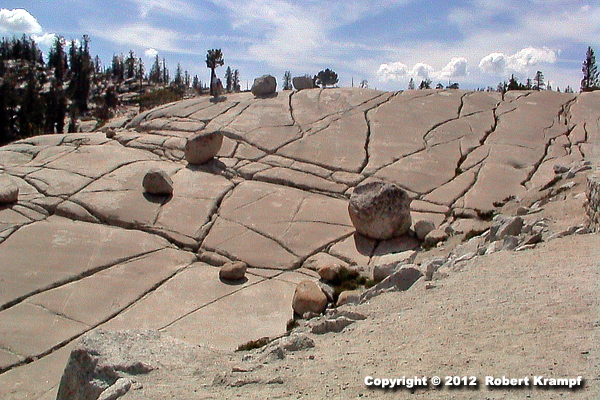
The large cracks in this rock are called expansion cracks. As the overlying rock erodes away, the rock expands, causing the cracks. The cracks are an example of:
-
Erosion
No. Erosion means that the pieces of rocks are being carried away. The overlying rocks have been eroded, but the cracks are not carrying the pieces to a new location. -
Weathering
Yes! As the rocks expand unevenly, tension builds up. When there is enough stress, the rocks break. That breaking of large rocks into smaller pieces is called weathering. -
Both erosion and weathering
No. The rocks are being broken (weathering), but the pieces are staying in place, so there is not erosion. -
Neither erosion nor weathering
No. The cracks show that the rocks are breaking, which is weathering..
Click to see which state standards this question tests, and which of my videos, experiments, and other resources support that topic.
Florida
SC.4.E.6.1 Identify the three categories of rocks: igneous, (formed from molten rock); sedimentary (pieces of other rocks and fossilized organisms); and metamorphic (formed from heat and pressure).
| Igneous Rocks and Bubbles | video, free, learnalong, Updated |
| Sedimentary Rocks | video, learnalong |
| What is a Rock? | video, learnalong, checked |
| Bioclastics: Rocks With No Minerals | video |
| Evaporites | video, learnalong, checked |
| Homemade Fossil Dig | text page |
| Foliated and Unfoliated Rocks | text page, learnalong |
| Identifying Igneous Rocks | text page, learnalong |
| Intrusive and Extrusive Igneous Rocks | text page, learnalong |
| Light and Dark Minerals | text page, learnalong |
| Review Rocks-1 | practice |
| Review Rocks-2 | practice |
| Review Rocks-3 | practice |
| Review Rocks-4 | practice |
| Review Rocks-5 | practice |
| Review Rocks-6 | practice |
| Review Rocks-8 | practice |
| Review Rocks-9 | practice |
| Review Rocks-7 | practice |
| Review Rocks-10 | practice |
| Review Rocks-10 | practice |
| Review Rocks-10 | practice |
SC.7.E.6.2 Identify the patterns within the rock cycle and relate them to surface events (weathering and erosion) and sub-surface events (plate tectonics and mountain building).
| What is a Rock? | video, learnalong, checked |
| The Rock Cycle | video, learnalong |
| Change: Fast and Slow | video |
| Erosion | video, checked |
| Continuous Change | video, checked |
| Bioclastics: Rocks With No Minerals | video |
| Weathering and Erosion | video, learnalong, checked |
| Evaporites | video, learnalong, checked |
| Review Rocks-1 | practice |
| Review Erosion-1 | practice |
| Review Erosion-2 | practice |
| Review Erosion-3 | practice |
| Review Erosion-4 | practice |
| Review Erosion-5 | practice |
| Review Rocks-4 | practice |
| Review Rocks-5 | practice |
| Review Rocks-6 | practice |
| Review Rocks-8 | practice |
| Review Rocks-9 | practice |
| Review Rocks-7 | practice |
| Review Rocks-10 | practice |
| Review Rocks-10 | practice |
Utah
UT.4.III.2.b Distinguish between weathering (i.e., wearing down and breaking of rock surfaces) and erosion (i.e., the movement of materials).
| Change: Fast and Slow | video |
| Erosion | video, checked |
| Weathering and Erosion | video, learnalong, checked |
| Review Erosion-1 | practice |
| Review Erosion-2 | practice |
| Review Erosion-3 | practice |
| Review Erosion-4 | practice |
| Review Erosion-5 | practice |
UT.5.II.1.a Identify the objects, processes, or forces that weather and erode Earth’s surface (e.g., ice, plants, animals, abrasion, gravity, water, wind)
| Change: Fast and Slow | video |
| Erosion | video, checked |
| Continuous Change | video, checked |
| Weathering and Erosion | video, learnalong, checked |
| Review Erosion-1 | practice |
| Review Erosion-2 | practice |
| Review Erosion-3 | practice |
| Review Erosion-4 | practice |
| Review Erosion-5 | practice |
UT.8.III.2.b Describe the role of energy in the processes that change rock materials over time.
| Igneous Rocks and Bubbles | video, free, learnalong, Updated |
| Sedimentary Rocks | video, learnalong |
| Change: Fast and Slow | video |
| Erosion | video, checked |
| Continuous Change | video, checked |
| Weathering and Erosion | video, learnalong, checked |
NGSS
4-ESS2-1 Make observations and/or measurements to provide evidence of the effects of weathering or the rate of erosion by water, ice, wind, or vegetation.
| Change: Fast and Slow | video |
| Erosion | video, checked |
| Continuous Change | video, checked |
| Weathering and Erosion | video, learnalong, checked |
| Review Erosion-1 | practice |
| Review Erosion-2 | practice |
| Review Erosion-3 | practice |
| Review Erosion-4 | practice |
| Review Erosion-5 | practice |
